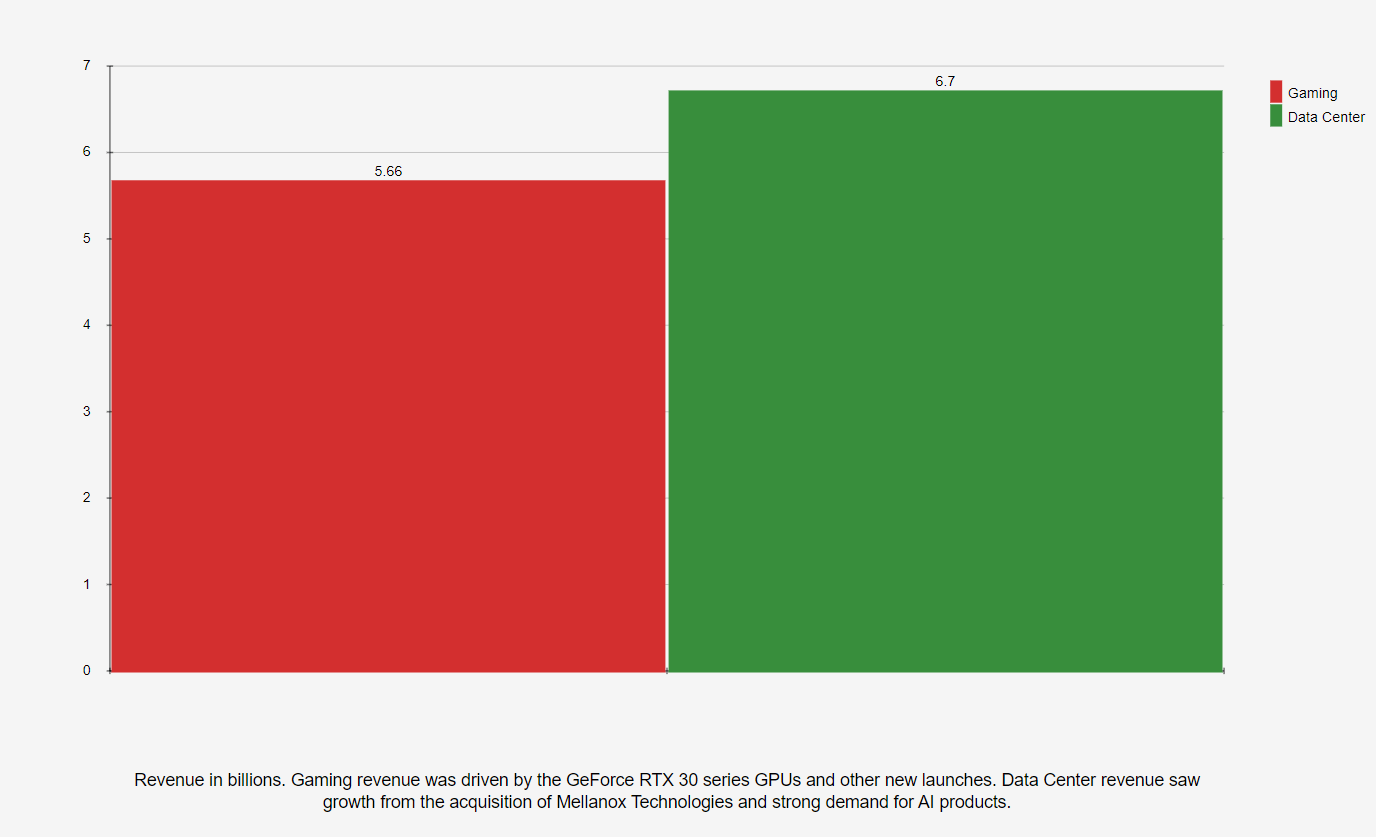- 29 August 2023
- 2 Comments
- 1318
Learn from the Rise of Nvidia: A Story of GPU and AI

I am Nabeel Shaikh, a seasoned Chartered Accountant with over 17 years of diverse experience in investment banking, management consulting, and entrepreneurship. In this blog post, I will discuss why Nvidia, the leading maker of graphics processing units (GPUs), has been making headlines recently with its impressive financial results, innovative products, and strategic partnerships.
The company, which started as a gaming hardware provider, has transformed into an artificial intelligence (AI) powerhouse that powers some of the most demanding applications in gaming, data centers, cloud computing, autonomous vehicles, healthcare, and more.
Nvidia’s Financial Performance
Nvidia’s revenue for the second quarter of fiscal 2024 was $13.51 billion, up 101% year-over-year and up 88% sequentially. The company grew from strong demand for its GPUs in all segments, especially gaming and data center. Nvidia’s gaming revenue was $5.66 billion, up 85% year-over-year and up 11% sequentially. The company said the growth came from the popularity of its GeForce RTX 30 series GPUs, which give stunning ray-traced graphics and AI-enhanced performance for gamers. Nvidia also launched new products for gamers, such as the GeForce RTX 3080 Ti and 3070 Ti graphics cards, the GeForce NOW cloud gaming service, and the NVIDIA DLSS 3.5 technology that uses AI to improve image quality and frame rates.
Nvidia’s Data Center Business
Nvidia’s data center revenue was $6.7 billion, up 123% year-over-year and up 205% sequentially. The company gained from buying Mellanox Technologies, a high-performance networking leader, in April 2023. Nvidia also had strong demand for its AI products and platforms, such as the NVIDIA A100 Tensor Core GPU, the NVIDIA DGX SuperPOD AI supercomputer, the NVIDIA EGX edge AI platform, and the NVIDIA Jarvis conversational AI framework. Nvidia’s data center customers include big cloud service providers, such as Google Cloud, Meta, and Microsoft Azure, and enterprises in various industries that use AI to transform their businesses.

Nvidia’s Generative AI Technologies
Nvidia leads gaming and data center markets, and also pioneers new fields like generative AI, autonomous vehicles, and healthcare. Generative AI can create new content or data from existing data or models. It can make realistic images, videos, sounds, texts, or designs for entertainment, education, or innovation. The company has made many generative AI technologies and applications, such as NVIDIA GauGAN that makes photorealistic images from sketches, NVIDIA StyleGAN that makes realistic faces, NVIDIA Maxine that improves video conferencing quality, and NVIDIA Omniverse that makes immersive virtual worlds.
Nvidia’s Autonomous Vehicle Solutions
Nvidia leads gaming and data center markets, and also pioneers new fields like generative AI, autonomous vehicles, and healthcare. Generative AI can create new content or data from existing data or models. For instance, it can make realistic images, videos, sounds, texts, or designs for entertainment, education, or innovation. Nvidia has made many generative AI technologies and applications, such as NVIDIA GauGAN that makes photorealistic images from sketches, NVIDIA StyleGAN that makes realistic faces, NVIDIA Maxine that improves video conferencing quality, and NVIDIA Omniverse that makes immersive virtual worlds.
In addition, Nvidia develops autonomous vehicle technologies for safer and smarter transportation. The company’s NVIDIA DRIVE platform is a complete solution for autonomous driving. It covers perception, planning, and control. It has hardware components like the NVIDIA DRIVE AGX SoC and software components like the NVIDIA DRIVE OS and the NVIDIA DRIVE AV. Nvidia’s DRIVE platform is used by over 300 companies worldwide that make autonomous vehicles or related services. Some of these companies are Mercedes-Benz, Volvo, Hyundai Motor Group, Zoox, and Nuro.
Nvidia’s Healthcare Applications
Nvidia is also applying its AI expertise to healthcare, where it aims to improve patient outcomes and reduce costs. The company’s NVIDIA Clara platform is a suite of tools and frameworks that enable developers and researchers to build and deploy AI applications for medical imaging, genomics, drug discovery, and more. Nvidia’s Clara platform is used by more than 100 healthcare partners globally that are working on various projects such as detecting COVID-19 from chest X-rays, accelerating genome sequencing analysis, discovering new drugs with AI models, and creating digital twins of human organs.
Nvidia’s Vision and Culture
Nvidia uses GPU technology to speed up computing and create new possibilities. The company’s motto shows its curiosity and passion for learning and innovation. Nvidia has strong performance, product portfolio, and partner ecosystem. It leads the AI revolution and shapes the future of computing.
Nvidia stands out by using GPU technology to make diverse and different products and solutions. Nvidia’s GPUs are powerful processors for graphics and computations. They are also versatile platforms for software frameworks and libraries. They help developers and researchers make and use AI applications easily and efficiently. Nvidia’s GPUs are scalable and adaptable. They work in different settings, from personal computers to supercomputers, from cloud servers to edge devices, from cars to robots, from hospitals to homes.
The company’s success comes from its culture of innovation and collaboration. The company spends a lot on research and development, $3.1 billion in fiscal 2023, 20% of its revenue. The company also promotes openness and sharing. It encourages its employees to publish research papers, join conferences and competitions, and contribute to open source projects. Nvidia works with various partners in academia, industry, and government, to improve AI and computing. Some of these partners are Stanford University, MIT, IBM, Samsung, and NASA.
Nvidia’s Future Plans
Nvidia has ambitious plans for the future, as it aims to expand its presence and influence in various markets and applications.
Nvidia’s Roadmap for GPUs and CPUs
According to its latest roadmap, Nvidia expects to launch its next-generation GeForce RTX 5000 series graphics cards in 2025, which could offer a significant performance boost over the current RTX 4000 series. The company also plans to introduce its first data center CPU, codenamed Grace, in 2023, which will compete with Intel and AMD in the server processor market.
Grace will be based on ARM architecture, which Nvidia is in the process of acquiring for $40 billion. The deal, if approved by regulators, will give Nvidia access to a wide range of technologies and markets that use ARM-based chips, such as smartphones, tablets, laptops, IoT devices, and embedded systems.
Nvidia’s Research and Development Projects
Nvidia is also investing heavily in research and development, spending $3.1 billion in fiscal 2023, which accounted for 20% of its revenue. The company is working on various projects and initiatives that could advance the state of the art in AI and computing. Some of these projects include:
- NVIDIA GPT-4: An NLP model that could beat OpenAI’s GPT-3 in scale and performance. Nvidia says it trained a GPT-4 model with 530 billion parameters, over twice as big as GPT-3, using its DGX SuperPOD AI supercomputer. The model could enable new conversational AI, text generation, summarization, translation, and more.
- NVIDIA Omniverse Enterprise: A platform for collaboration and simulation across industries and applications. Omniverse Enterprise lets users make, edit, and share 3D content in real time using Nvidia’s RTX technology and physics engine. The platform also supports software tools and frameworks used by professionals and developers, such as Autodesk Maya, Unreal Engine, Blender, TensorFlow, PyTorch, and more.
- NVIDIA Morpheus: A cybersecurity application framework that uses AI to detect and prevent cyberattacks. Morpheus uses Nvidia’s BlueField DPU and CUDA-X software stack to analyze network traffic and find anomalies and threats. Morpheus can also act to stop or block attacks in real time.
What Other Businesses Can Learn from Nvidia’s Story
Nvidia’s story inspires and teaches other businesses. They want to succeed in the AI era. Nvidia leverages its core competency, invests in R&D, embraces openness and interoperability, and is adaptable and scalable. These factors help businesses thrive in the fast-changing and competitive AI and computing landscape.
Leverage Your Core Competency
Nvidia’s core competency is its GPU technology, which it uses to build diverse and different products and solutions for various markets and applications. Nvidia’s GPUs are powerful processors for graphics and computations. They are also versatile platforms for software frameworks and libraries. They help developers and researchers make and use AI applications easily and efficiently. Nvidia’s GPUs are scalable and adaptable. They work in different settings, from personal computers to supercomputers, from cloud servers to edge devices, from cars to robots, from hospitals to homes.
Value for its customers, partners, and stakeholders is created by Nvidia by using its core competency. Various domains, such as gaming, data centers, cloud computing, autonomous vehicles, healthcare, and more are also expanded by Nvidia’s presence and influence. New possibilities for humanity, such as generative AI, conversational AI, simulation, and cybersecurity are also innovated and created by Nvidia
Other businesses can learn from Nvidia and use their own core competencies to make products and solutions for different markets and applications. By doing so, they can create value for their customers, partners, and stakeholders. They can also innovate and create new possibilities for their domains.
Invest in Research and Development
Nvidia invests heavily in research and development, spending $3.1 billion in fiscal 2023, which accounted for 20% of its revenue. The company is working on various projects and initiatives that could advance the state of the art in AI and computing. Some of these projects include NVIDIA GPT-4, NVIDIA Omniverse Enterprise, and NVIDIA Morpheus.
By investing in research and development, Nvidia has been able to stay ahead of the curve and maintain its competitive edge in the AI and computing industry. Nvidia has also been able to foster a culture of innovation and collaboration that encourages learning, sharing, and experimenting. Nvidia has also been able to attract and retain top talent in the field of AI and computing.
Other businesses can learn from Nvidia’s example and invest in research and development to stay ahead of the curve and maintain their competitive edge in their industry. By doing so, they can foster a culture of innovation and collaboration that encourages learning, sharing, and experimenting. They can also attract and retain top talent in their field.
Embrace Openness and Interoperability
Easy and efficient AI development and deployment are supported by Nvidia through software frameworks and libraries. Openness and sharing are also promoted by Nvidia, which encourages its employees to publish research papers, join conferences and competitions, and contribute to open source projects. Various partners in academia, industry, and government are also worked with by Nvidia, to improve AI and computing. Stanford University, MIT, IBM, Samsung, and NASA are some of these partners.
By supporting software frameworks and libraries, Nvidia increases its reach and impact in the AI and computing community. Nvidia also benefits from the community’s intelligence and creativity. Nvidia also builds trust and credibility with its customers, partners, and stakeholders.
Other businesses can learn from Nvidia and support software frameworks and libraries for easy and efficient AI development and deployment. By doing so, they can increase their reach and impact in their community. They can also benefit from the community’s intelligence and creativity. They can also build trust and credibility with their customers, partners, and stakeholders.
Be Adaptable and Scalable
Nvidia can adjust to market changes and customer demands. Nvidia can also make its products and solutions work in different settings, from personal computers to supercomputers, from cloud servers to edge devices, from cars to robots, from hospitals to homes.
By being adaptable and scalable, Nvidia meets the needs and expectations of its customers, partners, and stakeholders. Nvidia also seizes new opportunities and overcomes new challenges in the AI and computing industry. Nvidia also creates a sustainable and profitable business model.
Other businesses can learn from Nvidia and be adaptable and scalable. By doing so, they can meet the needs and expectations of their customers, partners, and stakeholders. They can also seize new opportunities and overcome new challenges in their industry. They can also create a sustainable and profitable business model.
Conclusion
Nvidia is a leading and innovative company in the world. The company makes cutting-edge products and solutions that power demanding applications in gaming, data centers, cloud computing, autonomous vehicles, healthcare, and more. The company also uses its GPU technology to speed up computing and create new possibilities. Nvidia is the talk of the town and the leader of the AI revolution.
Please share this with your friends and followers. And if you have any questions or comments, leave them below. I would love to hear from you. Don’t miss out and subscribe to NashFact.com today.




2 Comments
[…] Read more, check out: Learn from the Rise of Nvidia: A Story of GPU and AI […]
[…] Read more, check out: Learn from the Rise of Nvidia: A Story of GPU and AI […]